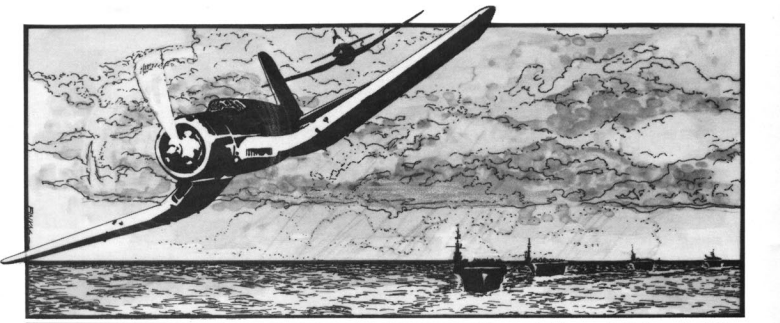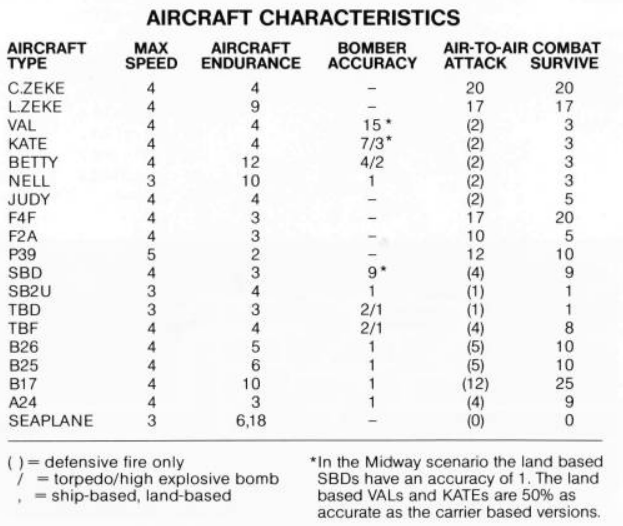
Carrier Force by Gary Grigsby, published by SSI, USA
First release : December 1983 on Apple and Atari 800
AAR : Coral Sea, Midway
Average duration of a campaign : 4-8 hours depending on the scenario
Total time played : 10 hours
Complexity: High (3/5)
Final Rating: Totally obsolete
Ranking at the time of review : 83/105
Gary Grigbsy’s Carrier Force focuses on the tactical if not the practical aspects of carrier warfare : scouting with individual air wings, managing deck slots for landing and take-off, etc. Alas, it dilutes the few real decisions the player takes into massive micromanagement, and the appalling UI sucks whatever fun is left after that.
Carrier Force is the fourth game by Gary Grigsby (after Guadalcanal Campaign, Bomb Alley and North Atlantic ’86) and marks his return to the Pacific theatre. Unfortunately, neither he nor SSI’s founder Joel Billings remember much about the game, especially given how many Pacific War games the duo would eventually release in their 40+ years-long career. The one thing they remember is that Billings felt Grigsby had to move to hex grids, a skill that would be absolutely necessary for his next game : War in Russia. While Grigsby’s earlier games had been exclusive to the Apple II, Career Force was written on the Atari before being ported, as per what had become SSI standard practice, to the Apple II and later the Commodore 64. It was sold for $59.95 with the standard SSI content (disk, manual and two maps).
A. Immersion
Very poor. Carrier Force’s ruleset is extremely realistic (according to my opinion anyway, Robert Evans strongly disagreed but more on this later), but horrible graphics and tedious tasks pull you out of immersion – you lose the grand picture when you spend half your time calculating whether you will have enough landing slots for all your planes.
B. UI, Clarity of rules and outcome.
Terrible. While the manual is relatively functional, this game has some of the worst UI I have ever seen :
- There is a map, but it only shows the fleets. Your air wings are never displayed on it so you need to remember their location,
- The game tells you how long your seaplanes have been in the air in hours, but when the same menu is opened for normal planes, then it tells you how long they can still fly in hours,
- Some menus (eg : the plane list) count from 0 to 8 and you need to press 9 to exit them because 0 selects a plane (specifically the F4F Wildcat), others (eg : base list) count from 1 to 9 and you need to press 0 to exit. Sometimes, those menus are one after the other. It seems trivial, but it drove me crazy,
- Let’s not even talk about surface combat resolution – undecipherable,
Worse : air wings play in a specific order ! Initially the orders in which they were created, and then if any early air wing is destroyed the new air wing will take its “slot”. This means that if one of your early seaplanes is shot down, you need to immediately launch a new seaplane to fill its slot lest any strike force you send is slotted low and plays before you have a chance to detect the enemy fleet this turn !
Everything in Carrier Force takes twice or three times longer than it needs to. A basic example : the game requires you to input the task force you want to land on even if there is only one eligible in the hexagon – which is 99% of the time. Other features seem designed to trigger stupid mistakes : each time the game calls an airwing to be played, the first question it asks is whether you want to jettison its ordinance…

C. Systems
Very poor. Compared to the earlier Grigsby’s games, Carrier Force moves the focus from the strategic and operational to the tactical. When scenarios last 3 or 4 days at most, you lose a lot of interesting decisions : when to repair and refit, how much risk you are willing to take when in pursuit, how to organize your transport fleets (fast and small, or slow and huge). What you gain is a lot of micro. Sure, you still take a few big decisions (the same ones that could have been taken in a more strategic game) but they are drowned in the minutia of moving planes on deck, making sure the carrier is going in the correct direction, making the planes take-off, moving 15+ “plane wings” (most of which are actually composed of just one seaplane) hexagon after hexagon, making sure there is enough room for the planes to land, and then actually landing the planes.
The game can sometimes capture that moment where you have to decide between putting planes on the deck and letting planes out of fuel land, but the price to pay in micromanagement is not worth it. The game also deprives you of small joys, like being informed that you have sunk one of the enemy ships. It is maybe realistic-ish, but it is not fun.
D. Scenario design & balancing
Adequate. The game includes 4 scenarios :
- Coral Sea (5 days)
- Midway (4 days)
- Eastern Solomons (2 days)
- Santa Cruz (2 days)
As usual, each is extremely detailed, with each fleet represented down to the minelayers or the seaplane launchers (critical for the Japanese), and a different plane set up on each carrier (“did you know that at the battle of Midway the USS Enterprise had 23 Wildcats while the USS Hornet had 27 ?”).

I played the two first scenarios, the two last ones are fairly similar (same general location for both fleets, though the number of carriers of each side is different) and probably play like the Midway scenario but with the opposing fleets starting further from each other. The game also includes an option to randomize the starting position of both fleets so you don’t know where to search. I am torn between wishing that the scenarios were longer so the “search” part of the game would be more interesting and wishing the scenarios were shorter because I just did not like the game. It may mean the scenarios are just as long as they should be.
The AI feels solid, though I believe it cheats by knowing more or less where your fleet is (loading the turn from the AI side, it consistently found my fleets with only a handful of seaplanes).
E. Did I make interesting decisions
Sometimes, but their density was way too low for battles lasting 4 hours or more.
F. Final rating.
Totally obsolete. I don’t think I would have liked the game very much even with the best UI – too micro-management focused – but with its horrible UI Carrier Force was a miserable experience.
Contemporary Reviews
Carrier Force came out strong with two reviews from Computer Gaming World that did not see any flaw with the game. In fairness, Floyd Matthews (February 1984) remains relatively neutral, possibly because as the disclaimer states he was a playtester on the game. On the other hand, Tom Cheche writes the happiest of all reviews in the April 1984 issue (“Carrier Force has been exhaustively researched, and beautifully produced“), an opinion maybe not totally uncorrelated to the disclaimer that Cheche had “provided historical research in the development of Carrier Force”. In any case, Cheche explains that computer games have three advantages over tabletop games :
- always providing an opponent – I agree,
- attending the “minute bookkeeping” – I disagree as I feel like I had more bookkeeping here than in most boardgames I played,
- allowing a true fog-of-war, because in most boardgames : “Search procedures had to be conducted one air group at a time, one hex at a time with the success or failure of the search in each hex being determined by the weather conditions and other factors. It was, at best, a chore“. Apparently, Carrier Force is totally different in this regard ! Well, I have to disagree also here.
Reviews written by people not actually involved in the development of the game are significantly less enthusiastic. Dave Dempster writing for TPUG in November 1986 echoes my opinion :
I got annoyed at having to continually ready, turn to wind, launch and land CAP (combat air patrol). I was not amused at being promoted to Admiral of the Fleet to set Task Force make-up, disposition and course, then being demoted to Lieutenant and plunked into the front seat of a PBY to go look for the enemy. Carrier Force tied me up so much in details, such as tracing the path for each of those necessary recce aircraft each turn, that I began to lose sight of the overall strategy. The game is difficult to finish, though it does offer the option of saving the game each turn. The action, if one gets to it, can be intense, but is short-lived. […] if you like a game with a lot of input, where you’re personally involved in detail, you may well enjoy Carrier Force very much. I did not.
Even those who liked the game complained about the UI, for instance Mike Markowitz writing for MicroTimes (May 1984) : “The moments of terror in the game are often the result of hitting a wrong key. There are few computer wargames that punish player errors as brutally as Carrier Force. A momentary lapse of attention, or careless keystroke can cause your bombers to jettison their weapons into the sea, send your planes off in the wrong direction, or (worst of all) cause entire airstrikes to crash because they are unable to land”.
Finally, there is the wargame expert Robert Evans. He reviews the game in the October 1984 issue of Current Notes and boy is it a carnage. You may want to read the review, but Evans really, really did not like the game : “slow“, “dependant on deus ex machina” (aka luck) and worst of all : “ahistorical” for a long list of reasons going from the effectiveness of the Japanese seaplanes to the optimal tactics to use to win. His conclusion : “A good “beer and pretzels” wargame may be historically inaccurate but fun; a simulation advertising itself as definitive with the inherent complexities ceases to be fun with the same flaws“. His later reviews of the game mellowed a bit, but he never liked it.
Despite its shortcomings, Carrier Force sold around 15 500 copies in the US, a major success for a wargame. The most successful of Grigsby’s earlier wargames – North Atlantic ’86, had sold 7 800 copies. As for me, I am done with Carrier Force, and the following Grigsby game will be on solid ground, but before we reach it we still have a few games to cover to end 1983. They may not be better, but I promise they will be less dry.